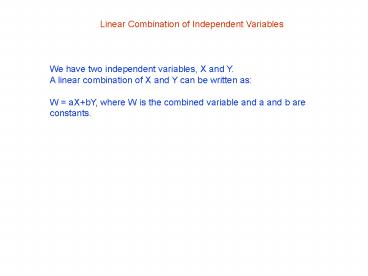Linear Combination of Independent Variables - PowerPoint PPT Presentation
1 / 45
Title:
Linear Combination of Independent Variables
Description:
A statistic is a numerical valued function of the sample ... The observed value of a statistic depends on the particular sample that happens to be selected. ... – PowerPoint PPT presentation
Number of Views:111
Avg rating:3.0/5.0
Title: Linear Combination of Independent Variables
1
Linear Combination of Independent Variables
We have two independent variables, X and Y. A
linear combination of X and Y can be written as
W aXbY, where W is the combined variable and
a and b are constants.
2
The mean of the linear combination is
If we multiply a variable by a constant, the
variance increases by a factor of the constant
squared.
3
The variance of the combined variable, W is
If the variable W is the sum of n independent
variables X, each of which has the same
probability distribution (and so the same
variance), then
4
The mean content of a box of cat food is 2.50 kg,
and the standard deviation of the content of a
box is 0.030 kg. There are 24 boxes in a case,
and there are 400 cases in a car load as it
leaves the factory. What is the standard
deviation of the amount of cat food contained in
(i) a case, and (ii) a car load?
The variance of the content of a box is
5
The variance of the content of a case is
The standard deviation of the contents of a case
is
6
The variance of the content of a car load is
The standard deviation of the contents of a car
load is
7
Sampling (Chapter 7 of Text)
A population might be thought of as the entire
group of objects or possible measurements in
which we are interested.
8
A sample is a group of objects or readings taken
from a population for counting or measurement.
From the observations of the sample, we infer
properties (parameters) of the population.
9
However, if these inferences are to be useful,
the sample must truly represent the population
from which it came.
The sample must be random, meaning that all
possible samples of a particular size must have
equal probabilities of being chosen from the
population.
10
A numerical feature of a population is called a
parameter.
The true value of a population parameter is an
unknown constant. It can be correctly determined
only by a complete study of the population.
11
If we only have access to a sample from the
population, our inferences about a parameter must
then rest on an appropriate sample-based
quantity. A sample-based quantity is called a
statistic.
A statistic is a numerical valued function of the
sample observations.
12
Important Aspects of Sampling
- Because a sample is only a part of the
population, the numerical value of a statistic
cannot be expected to give us the true value of
the parameter. - The observed value of a statistic depends on the
particular sample that happens to be selected. - There will be some variability in the values of a
statistic over different occasions of sampling.
13
The Sampling Distribution of a Statistic
The value of the sample mean, or any other
statistic, will vary as the sampling process is
repeated.
Because any statistic (e.g. the sample mean)
varies from sample to sample, it is a random
variable and has its own probability distribution.
14
The probability distribution of a statistic is
called its sampling distribution. It is often
called as distribution of a statistic.
15
Mean of Sample Means
Suppose that we have a population of N
observations from which we draw samples. Each
sample consists of n independent observations.
The mean of the kth sample is
16
The number of different samples that can be drawn
is the number of combinations of n elements taken
from a population of N.
17
Therefore, the mean of the means of all the
samples is
18
(No Transcript)
19
Consider all samples containing x1. There are
(N-1)!/(n-1)!(N-n)! samples that have x1.
Collecting all the terms containing x1, the
coefficient of x1 is
20
Similarly, the coefficient of x2 1/N and the
coefficient of x3 1/N, and so on.
mean of the original population
21
Variance of Sample Means
The variance of the means of samples of size n
drawn from a population of N is
22
(No Transcript)
23
(No Transcript)
24
(No Transcript)
25
(No Transcript)
26
(No Transcript)
27
(No Transcript)
28
(No Transcript)
29
(No Transcript)
30
(No Transcript)
31
Therefore, for sampling without replacement
32
For sampling without replacement, if N is very
large, then
33
For sampling with replacement (for both finite
and infinite population)
Notice that as the sample size increases, the
standard error of the mean decreases.
34
(No Transcript)
35
(No Transcript)
36
Central Limit Theorem
37
A population consists of one each of the four
numbers 2, 3, 4, 7. a) Calculate the mean and
standard deviation of this population. b) (i)
List all the possible and equally likely samples
of size 2 drawn from this population without
replacement. Calculate the sample means. (ii)
Find the mean and standard deviation of the
sample means from (i).
38
Mean of the population
39
Standard Deviation
40
(No Transcript)
41
All possible and equally likely samples of size
2 drawn from this population without replacement
are
(2, 3) (2, 4) (2, 7) (3, 4) (3, 7) and (4, 7)
The corresponding sample means are
42
(No Transcript)
43
Mean of the sample means
44
Standard deviation of the sample means
45
For sampling without replacement































